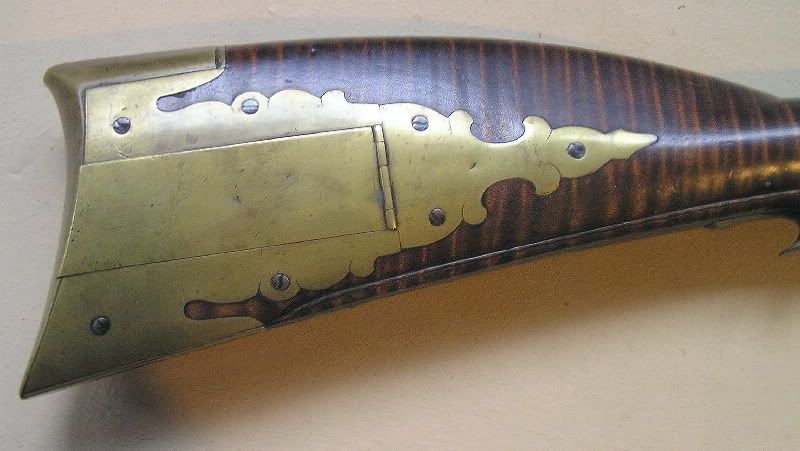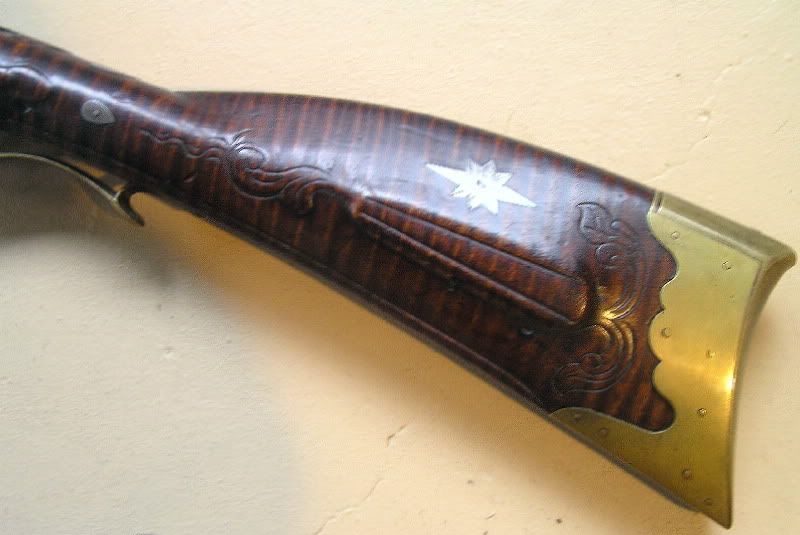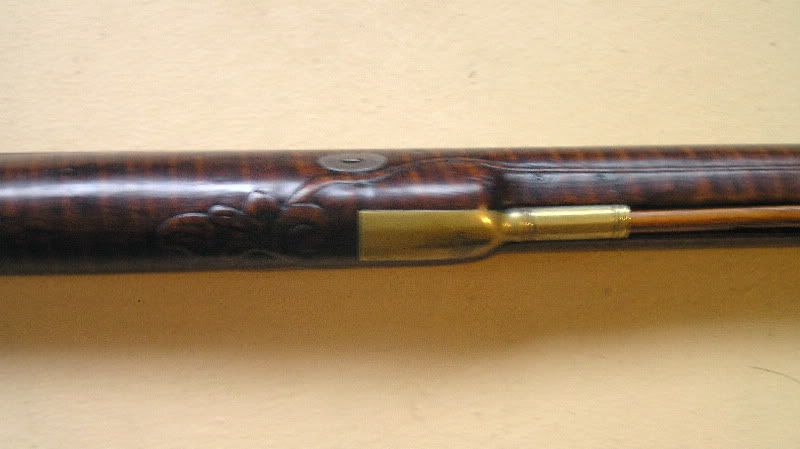Original flint, not one repair. 59 14/" OAL, 44" full octagon barrel, .58 caliber smoothbore, 13 3/8" pull. The brass work is exceptional and rather unique for this region.







Comments:
My vocabulary does not have the superlatives necessary to describe this gun, but I do wonder about the attribution. Shouldn't the barrel signature read "Haga" if it were signed?
-----------------------------------------------------------------------------------------------
I agree with you, nice rifle but it certainly appears to be from the Reading area and of the "Haga" style.
-----------------------------------------------------------------------------------------------
If my memory serves me right, there are no known guns signed W. Haga but there are certainly a lot of them attributed to him.
-----------------------------------------------------------------------------------------------
If I had a tendency toward illusion or fraud, I would have inscribed the barrel with a faint but believable "W * H" and I would have told myself and my friends that it stood for "XXXX." Long after I croaked, why, we have the first and only Wolfgang Haga...Hachen...take your pick. Who says ya' can't make history.
-----------------------------------------------------------------------------------------------
You are correct, there are no known signed Hagas, but, yes, the guys will probably agree that this looks like one should have.
-----------------------------------------------------------------------------------------------
Gentlemen, For some time now I have been referring to these style rifles as 'Borough of Reading' guns. It seems appropriate to get away from calling them Haga type guns as we have never seen a signed Haga. But we have seen rifles of this characteristic signed READING on the patch box lid and many of the originals found back in the 40's and 50's were found in or near the town of Reading, Pa. Kindig started the Haga identification because he thought the style represented the work of one man when in fact there are at least three different hands at work on examples from this school. Each man had his own different style of carving. However, these gunsmiths all used similar stock patterns, trigger guards, a variation of the same patch box finial and the same cheek rest design. In addition, several of the side plates, which are also of the same pattern, are marked with two file marks near each end. Others are marked with only 1 and others are blank as in this fine example. It may, in fact, mean that Haga had several men in his shop on more than one occasion producing rifles similar in style to his. This particularly nice example could have been made by Wm. Shener or Andrew Fichthorn Sr. or possibly John Gonter who moved to Reading around 1820. It appears too late to have been made by Haga who died in 1796. Until proven otherwise we can safely call this gun a product of the 'Borough of Reading' and a very interesting piece.
-----------------------------------------------------------------------------------------------
I agree with your point and eventually calling them "Borough of Reading" will get the point across. But the term "Haga type" has been in use for so long, it will tough to get away from that one.
-----------------------------------------------------------------------------------------------
A gorgeous Reading rifle with even more than the usual bells and whistles. The butt stock metal work may have inspired that which appears on the Angstat double gun in the display at the Reading Historical Society. There are also many other guns which are quite similar.
This is a truly fine rifle and the lucky owner deserves a round of applause for showing it around. It appears to me that is is a last decade, 1700 gun or no later than 1810 as it has early attributes, but some later style ornamentation added for effect. It has good early type carving, but some silver has been added, so more likely after 1800.
Any maker in Reading could have made this rifle and John Gonter has been mentioned as a candidate which I consider unlikely. He removed from Columbia/Lancaster to Reading in about 1820 and disappears, (died?), about 1822. By then, the Reading style had undergone modifications somewhat beyond what this piece exhibits. Many collectors simple refer to this type of rifle as a "Reading Rifle" which describes it pretty well.
The Haga myth notwithstanding, we may never know who produced these distinctive looking rifles which many people consider to be the real 'Kentucky Rifle.'
-----------------------------------------------------------------------------------------------
I have been referring to it as a Reading gun, so I feel somewhat vindicated by y'all. One of the appealing things about this one is that there has been absolutely no monkeying, fiddling or enhancing done at all. We can trace the provenance on this one back to the 1960's. For years it was in the collection of Dr. Jim Lucie of Fruitport, Michigan, long a member of KRA and past president of the American Society of Arms Collectors. Ron Gabel wrote of it in the KRA bill of sale: "This is one of the finest examples of the work of the Reading area gunmakers I have seen due to its untouched original condition." These Reading boys let a lot of their work loose without signing it.

